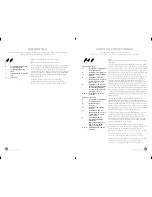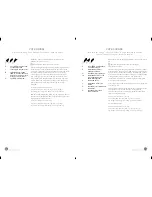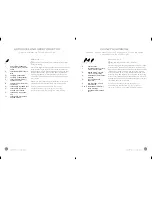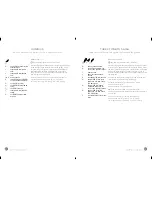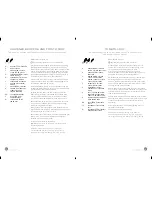
14
15
CLEaNING, STORaGE
aNd maINTENaNCE
Keep your Cuisinart Elite Collection
™
14-Cup
Food Processor ready to use on the kitchen
counter. When not in use, leave it unplugged.
This food processor includes a storage case
with lock for safekeeping of blades and discs.
Keep the blades and discs out of the reach of
children.
All parts except the housing base are
dishwasher safe, and we recommend washing
them in the dishwasher on the
top rack only
.
Due to intense water heat, washing the work
bowl, cover and accessories on the bottom rack
may cause damage over time. Insert the work
bowl and pushers upside down for drainage.
Remember to unload the dishwasher carefully
wherever you place sharp blades and discs.
To simplify cleaning, rinse the work bowl, cover,
pusher assembly and blade or disc immediately
after use so food won’t dry on them. Be sure to
place the pushers upside down for drainage. If
food lodges in the pusher, remove it by running
water through it, or use a bottle brush.
If you wash blades and discs by hand, do it
carefully. When handling, use the plastic hubs
on the blades for the discs. Avoid leaving them
in soapy water where they may disappear from
sight. To clean the metal blade, fill the work
bowl with soapy water, hold the blade by its
plastic centre and move it rapidly up and down
on the centre shaft of the bowl. Use of a spray
attachment is also effective. If necessary, use a
brush.
The work bowl is made of durable plastic, which
is shatter resistant and heat resistant. It should
not be placed in a microwave oven, as the
aperture at the front of the pusher houses the
metal rod that activates the motor.
The housing base may be wiped clean with a
soapy, non-abrasive material. Be sure to dry
once clean.
Four rubber feet on the underside keep the base
from moving on most work surfaces when the
machine is processing heavy loads. If the feet
leave spots on the counter, spray them with a
spot remover and wipe with a damp sponge. If
any trace of the spot remains, repeat the
procedure and wipe the area with a damp
sponge and nonabrasive cleaning powder.
ImPORTaNT:
Never store any blade or disc on
the motor shaft. No blade or disc should be
placed on the shaft except when the processor
is about to be used.
any other servicing should be performed by
an authorized service representative.
FOR YOUR SaFETY
Like all powerful electrical appliances, a food
processor should be handled with care. Follow
these guidelines to protect yourself and your
family from misuse that could cause injury.
Handle and store metal blades and discs
carefully. Their cutting edges are very sharp.
Always place the stem adapter on the motor
shaft before assembling the discs.
Never put blades or discs on the motor shaft
until the work bowl is locked in place.
Always be sure that the blade or disc is down
on motor shaft as far as it will go.
Always insert chopping blade and dough blade
in the work bowl before putting ingredients in
bowl.
When slicing or shredding food, always use the
pusher. Never put your fingers or spatula into
feed tube.
Always wait for the blade or disc to stop
spinning before you remove the pusher
assembly or cover from the work bowl.
Always unplug the unit before removing food,
cleaning, or putting on or taking off parts.
Always remove work bowl from base of machine
before you remove chopping blade or dough
blade.
TECHNICaL daTa
The motor in your food processor operates on a
standard line operating current. The appropriate
voltage and frequency for your machine are
shown on a label on the bottom of the base.
An automatic, temperature-controlled circuit
breaker in the motor ensures complete
protection against motor burnout. If the
processor runs for an exceptionally long time
when chopping, mixing or kneading a thick or
heavy mixture in successive batches, the motor
may overheat. If this happens, the processor will
stop. Turn it off and wait for the motor to cool
before proceeding. It will usually cool within 10
minutes. In extreme cases, it could take an hour.
Safety switches prevent the machine from
operating when the work bowl or the cover is
not locked into position. The motor stops within
seconds when the motor is turned off, and when
the pusher assembly is removed, a fast-stop
circuit also enables the motor to stop within
seconds.
Cuisinart offers a Limited Three-Year Warranty
on the entire machine.
FOOD
TOOL
YIELD
DIRECTIONS
Egg Whites
Metal Blade
Chop
8 egg whites = 1 cup (250 ml) firm
whites
Egg whites should be room temperature; add 1 teaspoon
(5 ml) lemon juice or vinegar per white. Process in an
absolutely clean bowl for 1 to 2½ minutes until surface
develops ridges and mass of whites almost stops
moving. These egg whites should not be used in
meringues. For whipped egg whites with volume, whip
with whisk or electric mixer.
Meat, Poultry &
Fish
Metal Blade
Metal Blade
Slicing Disc
Chop
Purée
Slice
2¼ pound boneless =
4½ cups (1 L)
1 pound boneless =
2 cups (500 ml)
1 pound boneless =
2 cups (500 ml)
Cut
very
cold raw or cooked meat/poultry/fish into
1-inch (2.5 cm) pieces; pulse to chop. Process for a few
seconds at a time for a finer chop. Check texture often
to avoid overprocessing.
Cut
very
cold raw or cooked meat/poultry/fish into
1-inch (2.5 cm) pieces; pulse to chop. Process
continuously until desired texture.
Slicing cooked meat/poultry: be sure it is
very
cold. Use
a single chunk of meat at a time. Slicing raw meat/
poultry: cut to fit feed tube; wrap in plastic to briefly
freeze. Raw meat is ready to slice when hard to the
touch but can easily be pierced with tip of a sharp knife.
Milk Shakes/
Smoothies
Metal Blade
Chop/ Purée
Can make up to 16
8-ounce (227 g) servings.
Milkshakes: add ice cream first; process and add milk
through feed tube. Smoothies: add fruit first, then add
the liquid while processing.
Nuts
Metal Blade
Metal Blade
Slicing Disc
Shredding
Disc
Chop
Purée
Slice
Shred
(fine/med.)
¾ pound = 3 cups (750 ml)
¼ pound = 1 cup (250 ml)
¼ pound = 1 cup (250 ml)
¼ pound = 1 cup (250 ml)
Pulse to chop. Hardness of nut dictates amount and time
of processing. If either flour or sugar is added to nuts
during processing, they can be processed as long as
possible without becoming butter. Coarsely chopped
nuts: 6 to 8 pulses. Finely chopped nuts: pulse 2 to 3
times, then process 20 to 30 seconds, watching
carefully for desired consistency.
Nut butter: process nuts 2 to 3 minutes, scraping bowl
as necessary. For smoothest consistency, add some oil
to nuts while processing.
Medium pressure; nuts will have a coarse texture.
Medium pressure; nuts will have a fine/medium texture.
Granulated Sugar
(to make extra
super-fine sugar)
Metal Blade
Chop
1 pound = 2 cups (500 ml)
Process 1 minute, or until fine.
Tofu
Metal Blade
Purée
10 ounces = ¾ cup (175 ml)
Drain; process 2 minutes or until smooth.
Whipping Cream
Metal Blade
Chop
1 cup (250 ml) = ½ cup
(125 ml) whipped
Process well-chilled cream until cream begins to thicken.
Add sugar as desired; process continuously until cream
reaches desired consistency (about 3 to 4 minutes).
DOUGHS
Pastry Dough
Metal Blade
Mix
Pulse mixture until it has consistency between cornmeal
and small pebbly crumbs. Add water, 1 tablespoon (15
ml) at a time; pulse until a dough forms.
Batters
Quick Bread,
Cake & Cookies
Metal Blade
Mix
First sift dry ingredients together by processing; remove
and reserve. Process the fats and sugars together and
then add any remaining liquid ingredients. Pulse in
reserved dry ingredients. Any ingredients that need to be
coarsely chopped can be added with dry ingredients.
For finely chopped ingredients, chop separately in small
work bowl and then add to batter at the end.
Yeast Dough
Breads
Metal Blade
Dough Blade
Mix
Knead
TIPS:
Use ¾ cup (175 ml) warm liquid to proof 2¼
teaspoons (11.25 ml) dry active yeast. Sugar/honey aids
in activating yeast, so add a small amount, about 1
teaspoon (5 ml) , to the warm liquid/yeast mixture when
proofing. Food processor can handle up to 6 cups (1.5 L)
white flour for a yeast bread dough. The dough should
have a soft, pliable texture and feel only slightly tacky.*
Sweet Dough
Breads & Coffee
Cakes
Metal Blade
Dough Blade
Mix
Knead
See
TIPS
above, but keep in mind that sweet doughs
will be rich and sticky and may not clean sides of bowl;
bowl may need to be scraped. Sweet doughs require
less kneading once the ingredients are mixed.*
Note:
Use dough blade for kneading dough in the large bowl only. The small bowl may not be used for dough. *See troubleshooting for additional
direction and techniques.
PROCESS

















